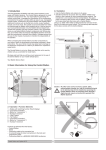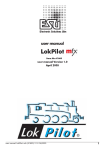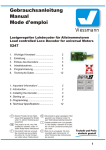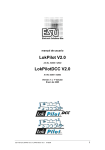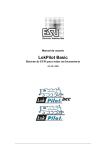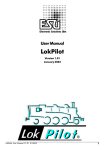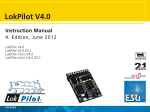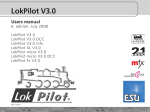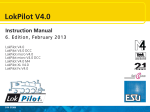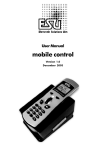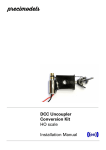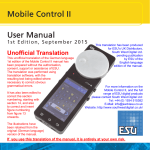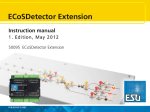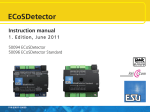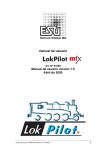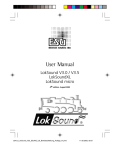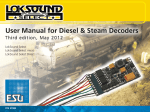Download LokSound LokPilot and LokPilot DCC V2 User Manual
Transcript
user manual LokPilot V2.0 Art-No. 52600 / 52602 LokPilotDCC V2.0 Art-No. 52601/ 52603 Version 1.1, 1st edition January 2005 user manual LokPilot V2.0 / LokPilot DCC V2.0 01/2005 1 General Features: LokPilot V2.0 is the successor of the popular LokPilot decoder. It enhances the already outstanding properties with more features with the objective, to improve running characteristics even more, to increase reliability and flexibility. LokPilot V2.0 is available in two types: LokPilot V2.0 is a multi-protocol-decoder. It supports Märklin / Motorola as well as the widely used DCC system. It can also be used in analogue layouts with AC or DC supply. Thus it is the ideal decoder even for layouts with combined Motorola / DCC controls. LokPilotDCC V2.0 is „thoroughbred“ DCC Decoder. It provides all functions of LokPilot V2.0, except for the Motorola-protocol and can also be used in analogue mode (DC only). Both decoders are the premier choice for the demanding model train enthusiasts who insist on excellent load control – particularly at low speeds – and maximum flexibility in terms of adapting the decoder to the model engine. LokPilot V2.0 detects the operating mode automatically and can control DC motors, coreless motors (e.g.: Faulhaber) or universal motors with HAMO-magnets. Due to its unique features LokPilot V2.0 offers great flexibility and reliability, as you have come to expect it from a top quality decoder. Even future updates are no problem for LokPilot V2.0: Due to its flash memory technology it can be updated to the latest version at any time. Properties of LokPilotDCC V2.0: • Fully operational on analogue DC layouts •Fully automatic change of operating mode (autodetect) th • 4 generation load control: to be adapted to motor characteristics with three CVs •40 kHz tact frequency for smooth and silent motor control • Supports Lenz Brake sections • Improved function mapping: All outputs can be assigned to any function button • Lighting effects: Strobe, Double Strobe, Mars- und Gyro light, Firebox, Blinker, Flash. • 2 directional outputs for headlights for up to 180 mA each • 2 auxiliary outputs (F1 und F2), for up to 180 mA each • Maximum total current of all 4 outputs: 350 mA •Adjustable acceleration and maximum speed even in analogue mode • Motor output: maximum 1.1 A, over current guard • Total maximum load of decoder: 1.2 Amps •Dimensions: 23 x 15.5 x 6.5 mm • Designed for the future due to possible firmware upgrade with flash-memory Additional features of LokPilot V2.0: • Suitable for analogue AV layouts • Supports Motorola-format (old and new) • Programming mode for Märklin 6021 (for the most important functions) Important note: • The LokPilot V2.0 and LokPilotDCC decoders are designed for use in model railways only • Avoid mechanical force and impact on the decoder • Do not expose to wet and humid conditions • Do not remove the heat shrink sleeve around the decoder • Never solder on the circuit board, extend cables if necessary • Never wrap the decoder in insulation tape, since this may cause overheating • 14, 28 and 128 speed steps in DCC-mode • Always disconnect the circuit when installing the decoder • Automatic detection of speed step setting inmost DCC-systems • Make sure that no blank wire ends come into contact with any metal parts of the locomotive • 2- or 4-digit address • Make sure that no wires are squeezed or cut by the model’s transmission parts when reassembling the locomotive. • Fully compatible with NMRA-standards • Shunting speed • Acceleration and deceleration can be switched off • Advanced Consisting • Freely selectable speed curve 2 user manual LokPilot V2.0 / LokPilot DCC V2.0 01/2005 Pin Description Colour code 1 motor connection right 2 backup light orange yellow 3 function F1 green 4 track connection 1 black 5 motor connection left grey 6 light front white 7 common (+pole) blue 8 track connection 2 red 1 = orange 5 = grey Fig. 1 - Interface as per NEM 650/652 green violet yellow F1 F2 light back white light front LokPilot blue black red orange grey engine Fig. 2 - Wiring of LokPilot with isolated funktions green violet F1 F2 yellow withe light back light front LokPilot chassis orange balck red grey engine Fig. 3 - Wiring of LokPilot with the common pole connected to the chassis user manual LokPilot V2.0 / LokPilot DCC V2.0 01/2005 3 Prior to installation The locomotive must be in perfect technical condition prior to installation. Only a locomotive with a troublefree mechanism and smooth running properties in analogue mode should be converted for digital mode. Wear and tear parts, such as motor brushes, wheel contacts, light bulbs, etc. must be inspected and cleaned or replaced if necessary. All work has to be carried out with the locomotive placed on a suitable base (not the track) and definitely un-powered. Make sure there can never be any electrical power applied to the loco during the conversion – even inadvertently. Locomotives with DCC Interface The LokPilotDCC is equipped with an interface as per NEM 650/652 (NMRA page 9.1/9.2 - see fig. 1). Installation in locomotives with interface is therefore particularly easy: • Remove the body from the chassis. Please refer to the instructions provided with your locomotive! • Remove the plug from the DCC socket. Please keep it for later use. •Insert the plug in such a way that pin 1 of the plug (near the red / orange wires) is located next to the point marked *, +, . or 1. Please take care to avoid bending the pins. Do not rely on the assumption that the wires have to lead from the socket in a certain direction: only the position of pin 1 determines which way the plug has to be inserted. • Locate the decoder at a suitable position within the locomotive. Most modern models have sufficient space for a decoder. Use double sided adhesive tape or a small amount of hot glue. a) If directional headlights and functions are isolated from the locomotive body proceed as per figure 2. b) Directional headlights and functions may be connected with their common to the track voltage (e.g. almost all Maerklin® -locomotives and older Fleischmann or ROCO locomotives are wired like that) as per figure 3. • Connect the red wire to the right rail pickup (or centre pick up in AC models), • and the black wire to the left rail pickup (wheels in AC models). • Connect the orange wire with the motor terminal, which was originally wired to the right wheel pick up (centre pick up in AC models). • The grey wire goes to the terminal, which was originally connected to the left rail (common rails for AC models). • Solder the back up lights to the yellow wire, the front headlights to the white wire. • Connect the green wire to the function output, which you want to switch with function button F1. • Connect the purple wire with the function output, which you want to switch with the function button F2. If your locomotive is wired as per b) above, then wiring is completed. In the case as per fig. 2 you have to connect the second pole of all light bulbs or other loads to the blue wire. The blue wire must not be connected to the chassis! Connecting Auxiliary Functions Locomotives without interface First separate all wires in the locomotive and make sure there is no hidden connection from one of the motor terminals to the chassis or the wheel contacts. The motor terminals definitely must be insulated. Fleischmann models often have such a connection, which can easily be overlooked. Check all connections using an Ohmmeter and make sure there are no short circuits between the motor terminals and the wheel contacts. How to proceed depends on how the headlights and other functions are wired: 4 Any load may be connected to the light and function outputs as long as it doesn’t exceed the maximum current. Please note that the overload protection of the decoder responds very quickly and will switch off all functions immediately in case of overload or short circuit. Therefore use only 16 V bulbs or higher and a maximum nominal current of 50 mA: Incandescent lamps have a high starting current and this may activate the overload protection of the decoder when the lights are switched on. user manual LokPilot V2.0 / LokPilot DCC V2.0 01/2005 Use only digital smoke generators (e.g. Seuthe No. 11) for locomotives whose light and function outputs are connected as shown in figure 2. All other smoke generators may draw too much current. Some commercially available smoke generators have a higher nominal current than 250 mA! Locomotives that are connected as shown in figure 3 need an analogue smoke generator e.g. Seuthe No. 10. Make sure that the total current for all function outputs does not exceed the permitted current rating and avoid short circuits between outputs. Although outputs of LokPilotDCC decoders are protected, high voltage on the terminals or a short circuit may damage the decoder! Set-up and initial operation Before replacing the body and reconnecting the engine it is recommended to carry out a function test. The factory pre-set address is 03. • Does the locomotive move in either direction? • Turn the lights on: are they operating correctly? If the LokPilotDCC V2.0 decoder is used in a locomotive with NEM interface: check if the NEM connector is plugged in correctly. DCC-Mode Remove capacitors that may be connected to the track section (e.g. in ROCO connecting track). They may impede normal operation of the decoder and even destroy it. LokPilotDCC may be operated with any DCC compatible system. The automatic speed step detection was tested with the following devices: ROCO Lokmaus2, Uhlenbrock Intellibox, Lenz Digital plus V2.3, ZIMO MX1. When using Lenz digital plus V3.0 the auto-detect feature does not operate in 14-speed step mode. Change to 28/128 speed steps. LokPilotDCC attempts to detect the speed step setting every time the system is powered up and the lights are turned on. In order to accomplish this you have to switch on the lights and vary the speed setting until the lights burn consistently. If you want to change the speed step setting during operation, you have to disconnect the circuit/track/locomotive to activate the auto-detect feature The auto-detect feature can be turned off with CV 49 Bit 4 (refer to the table on page 8). user manual LokPilot V2.0 / LokPilot DCC V2.0 01/2005 Motorola-mode (not for LokPilotDCC V2.0) The LokPilot V2.0 can be used with all Märklin® devices or compatible systems previously sold or currently on the market. The functions F1 to F4 can only be activated with the so-called „new Motorola®format“. To activate this, the DIP switches 1 and 2 on the 6021 have to be set to the upper position („On“). Adjusting decoder parameters The LokPilot V2.0 supports many parameters. A detailed list is provided at the end of this manual. All adjustable parameters are stored in so called CVs (configuration variables). They can be adjusted individually, depending on the type of command station. Please refer to the relevant chapters in the manual of your digital system (e.g.: programming of DCC decoders). The LokPilot V2.0 supports all programming methods as per NMRA. Programming Märklin 6020 / 6021 Märklin central units 6020 and 6021 have to be dealt with differently. Only parameters up to number 80 are available, provided the desired number is also below 80. Proceed as follow to adjust these CVs (not for LokPilotDCC V2.0): (The throttle must be set to 0. No other engines may be on the layout. Take note of the blinking lights of the engine!) • Press the „Stop“- and „Go“-buttons of the 6021 at the same time (simultaneously), until a Reset is triggered. (alternatively pull the mains plug and replug afterwards) • Press the „Stop“-button in order to turn off the track voltage • Enter the current decoder address (alternative: „80“) • Activate change of direction with the throttle (turn the knob left over the „Stop“-position until you hear a click), hold the knob there and press the „Go“-button • The LokPilot V2.0 is now in programming mode (headlights are blinking) • Enter the number of the parameter (CV) you want to change (two digits). • Confirm by pressing „change of direction“ (now the headlights blink in double mode) • Enter the new value for the register (two digits) •Confirm by pressing „change of direction“ (headlight are on for 1 second and then start blinking) 5 • Now you can change other register in the same manner • You exit the programming mode by selecting register „80“ or by turning off the track voltage for a moment (press „Stop“-button on 6021, then „Go“-button) Please note: • The value „0“ can not be entered with 6021. Instead you have to enter „80“. • Only CVs from 01 to 80 can be changed. • For adjusting CVs higher than 80 you have to use a DCC-compatible command station. • For easy and comfortable programming of ESU decoders we recommend the ESU LokProgrammer Nr. 53450. With its assistance you can comfortably programm your LokPilot V2.0 on your PC. More information regarding the ESU LokProgrammer can be found on our website. Tips und Tricks Adjusting Load control Decoder-Reset You can easily reset the decoder by writing the value 08 in CV 08 at any time. Function mapping The outputs can be assigned to any function button. ESU utilises the so-called Enhanced Mapping with the advantage that each function can be assigned to any function button. Furthermore the assignment can vary subject to direction of travel. It is also possible to trigger several functions with one button simultaneously. Each function button is assigned two CVs per direction (so-called control CVs A, B,) to determine the desired behaviour of each button. Figure 4 on page 10 shows the possible combinations. Generally it can be said: • All function buttons are directional. If you change the assignment of any function button, please do so for both directions. • Your digital system may not support all function buttons. The load control of the LokPilot V2.0 can be adapted to different types of motors. The standard settings match most motors very well but may have to be adjusted for other models. This is particularly true for coreless motors (Faulhaber, Maxxon) where we recommend to set the K-value (CV 54) to a lower value. • Each physical output must be assigned to a function button and also has to be „switched on“ initially. Parameters for Fleischmann Switching on function outputs Locomotives with the traditional round motor by Fleischmann should be programmed as follows: Prior to use each function output can / must first be switched on. Furthermore each output offers the possibility to set one of 10 different lighting effects: CV 54 = 14 - 18 CV 55 = 20 Parameters for Märklin® high performance motors The 5-pole high performance motor by Maerklin® (series 37xxx) is best suited for the LokPilotDCC when programmed as follows: CV 54 = approx. 20 - 25 CV 55 = 38 Parameters for coreless motors Later on we will show some examples to provide a better understanding. Before we have to explain two more properties of function outputs: • Dimmer: normal, continous output • Blinking: output blinks with adjustable frequency. • Inverse blinking: Output blinks as before, but with opposite timing. Thus alternate blinking lights can be set. • Strobe • Double Strobe • Random, Firebox • Smoke, adjusting the intensity of the smoke generator CV 54 = approx. 4 - 10 • Zoom, high beam and dimmed lights CV 55 = approx. 3 - 8 • Mars light • Gyro light 6 user manual LokPilot V2.0 / LokPilot DCC V2.0 01/2005 There is one CV fro each output (CV 113 - 116), in which the desired mode can be saved. Please note that you can deactivate each output by setting it to 0 if it is not required. Ex works the lighting outputs are set to „on“ and for steam engines AUX – 1 is to be switched with the headlight button. the column for function AUX 1 you will find a number in the heading of this column. In our example it is a „4“. This value has to be written into CV 171. Then the F5 button controls AUX 1. Thus the function is switched in forward mode. In order to also switch this function in back up mode you have to enter the same value in CV 174. Adjust lamp brightness The LokPilot V2.0 offers the feature to adjust the brightness of lamps in 15 steps in order to adapt the light intensity optimally to the specific model. The lamps are supplied with pulses, i.e. they are switched on and off very frequently. The desired brightness (0 – 15) must be set in the appropriate control CV (113 – 116) by adding it to the value corresponding with the type of function. Blinking frequency and duration of cycle CV 112 determines the blinking frequency (subject to the duration of the cycle) as well as the „on/off“ ration for all outputs set to blinking. The cycle can be set in 33 different steps. The cycle is always a multiple of 65.5 milli seconds. The „on/off“ ratio can be set in 16 steps (from 1/16 to 16/16). At a ratio of 8/16 the „on“ and „off“ period is equally long. The value to be entered in control CVs 113 – 116 can be calculated as follows: Cycle (value: 0-15) + 16 + On / Off ratios. • Example 2 2: Blinking light on AUX2 and F6. A blinking light should be wired to AUX 2 and assigned to the F6-button. The brightness is to be set to 6/15 of maximum brightness. The blinking cycle and on/ off ration are to be set as described above. First we need to activate output AUX 2 and set it to blinking mode. CV 116 is responsible for this. In our example we enter 32 (for blinking mode) + 5 (corresponds to 6/15 of maximum brightness) = 37. Now we have to assign AUX 2 to button F6. The control CV 177 is responsible for F6. We enter in this CV which functions should be switched with the F6 button. If you follow the row for „F6 forward“ in the table in figure 4 to the right until it meets the column for AUX 2 you find the number „8“ at the top of the column. This value has to be entered into CV 177. Now the F6 button switches AUX 2 in forward mode. To also set the F6 button for back up mode, enter value 8 in CV 183. • Example 3 3: Braking time On / Off with F5. Examples: • Example 1 1: smoke generator on AUX 1 and F5. Let’s assume you want to operate a smoke generator with function button F5 and output AUX 1. Output AUX 1 must be activated and the F5-button has to be assigned: First you activate the output; in this case we want a continuous output (dimming setting at 100% brightness). CV 115 is responsible for this output. The value to be entered in CV 115 has to be calculated as follows: 15 for maximum brightness. Now the function button has to be assigned to output AUX 1: Have a look at figure 4: Control CV 171 is responsible for button F5 in forward mode (third column). You have to enter in CV 171 which functions should be triggered with F5. If you follow the row for F5 in the table in figure 4 to the right until it meets user manual LokPilot V2.0 / LokPilot DCC V2.0 01/2005 Acceleration / deceleration should be controlled with F5. Since acceleration / deceleration does not represent a physical output but rather a logical output this function does not have to be configured. Only the button F5 has to be assigned to acceleration / deceleration. This is done with CV 172 where you enter the value „1“ (also refer to figure ??). If this function should also work in back up mode value „1“ has to be entered in CV 175. For configuring function outputs we recommend using your PC and the ESU LokProgrammer. The LokPilot V2.0 decoder offers many possibilities and combinations of functions and therefore a PC and the ESU LokProgrammer (Art. No.: 53450) are extremely useful for programming. 7 Settings for analogue mode Support and Assistance With the aid of CVs 125 and 126 you can adjust the starting and maximum speed for analogue DCoperation. In analogue AC operation CVs 127 and 128 are responsible (not for LokPilotDCC V2.0). Thus you can adjust the various speed settings even in analogue operation. Your first port of call with any questions is the dealer where you purchased the LokPilot V2.0 decoder. He is your competent partner for all your questions related to the model train hobby. LGB-control When using LGB-command stations or the Roco Lokmaus I the LokPilot V2.0 can be set to pulse control. Set bit 5 in CV 49 for this purpose. Subsequently the decoder counts the number of times the F1 button is pressed in sequence in order to be activated the desired function. Thus you can trigger all available functions by pressing the F1 button the appropriate number of times. Brake sections You may also contact us directly. For enquiries please use either email or fax (don’t forget to provide your own fax-no.) and we will reply within a few days. Please call our hotline only in case of complex enquiries that can’t be dealt with by email or fax. The hotline is often very busy and you may encounter delays. Also check our website for more information. You will find many hints under „Support / FAQ“ and even feed back from other users. The LokPilot V2.0 decoder supports the most commonly used brake systems: • Lenz-Brake generator in DCC-mode Of course we will be pleased to assist you. You can contact us at: • Märklin® Brake section (not LokPilotDCC V2.0) As soon as a brake command is recognised the LokPilot V2.0 decoder slows down the engine with the deceleration set in CV 4. After the enforced stop the engine accelerates as per the setting in CV 3. In order to active this feature certain settings have to be entered in CV 51. By telephone: ++49 (0)700 – LOKSOUND ++49 (0)700 – 56576863 Tuesdays: from 10.00 am to 12.00 noon Wednesdays: Lenz Brake generator The Lenz LG100 works in compliance with the mechanisms described by the NMRA and is fully supported by the LokPilot V2.0 decoder. Write value 8 in CV 51. from 10.00 am to 12.00 noon Per Fax: ++49 (0)700 - 37872538 Per email: [email protected] Per mail: ESU electronic solutions ulm GmbH - Technical Support Industriestraße 5/2 Märklin®-Brake section In principle the Märklin®-Bake section applies DC to the track instead of the digital signals. In order to activate this mode the value 1 has to be written in CV 51. The Märklin®-Brake section and the analogue DC operation should never be active at the same time, because the DC supply of the Märklin® Brake section could be interpreted as analogue DC-mode. Turn off the analogue mode in CV 50 to avoid this. The Märklin Brake section is not available for the LokPilotDCC V2.0. 8 D-89081 Ulm Internet: http://www.loksound.de user manual LokPilot V2.0 / LokPilot DCC V2.0 01/2005 F0 F0 F1 F1 F2 F2 F3 F3 F4 F4 F5 F5 F6 F6 F7 F7 F8 F8 F9 F9 F10 F10 F11 F11 F12 F12 Description value stand forward stand backward drive forward drive backward light forward light backward key F1forward key F1 backward key F2 forward key F2 backward key F3 forward key F3 backward key F4 forward key F4 backward key F5 forward key F5 backward key F6 forward key F6 backward key F7 forward key F7 backward key F8 forward key F8 backward key F9 forward key F9 backward key F10 forward key F10 backward key F11 forward key F11 backward key F12 forward key F12 backward 129 132 135 138 141 144 147 150 153 156 159 162 165 168 171 174 177 180 183 186 189 192 195 198 201 204 207 210 213 216 Headlight 1 1 Back-up lights 2 2 AUX 1 4 4 4 AUX 2 8 8 8 16 32 64 128 Control CV B value 130 133 136 139 142 145 148 151 154 157 160 163 166 169 172 175 178 181 184 187 190 193 196 199 202 205 208 211 214 217 Acceerationl on / off 1 1 1 Shunting modeon / off 2 2 2 Fig. 4 Function Mapping user manual LokPilot V2.0 / LokPilot DCC V2.0 01/2005 9 Control CV A Function button List of all supported CVs CV Name Description Range default value 1 Address address of locomotive 1 – 127 3 2 Starting voltage determines the starting speed 1 – 75 3 3 Acceleration This value multiplied by 0.869 gives the time from stop to maximum speed 0 – 64 8 4 Deceleration This value multiplied by 0.869 gives the time from maximum speed to stop 0 – 64 6 5 Maximum speed maximum speed of locomotive 0 - 64 64 6 Medium speed Speed of locomotive at medium speed step 0 - 64 22 7 Version number Internal software version of LokPilotDCC (read only) - 8 Manufacturer’s ID Manufacturer’s identity (ID) of ESU Writing value 8 triggers a reset of all CVs to factory values 13 Analogue mode F1-F8 Setting of functions F1 to F8 in analogue mode Bit Function 0-255 1 0-255 3 Long address of locomotive 128 - 192 CV 17 contains the higher value Byte (Bit 6 and 9999 0 Function F1. 14 Analogue Mode FL, F9-F12 1 2 2 Function F3 4 3 Function F4 8 4 Function F5 16 5 Function F6 32 6 Function F7 64 7 Function F8 128 Setting of functions FL, F9 to F12 in analogue mode Value 0 Function FL(f) 1 1 Function FL(r) 2 2 Function F9(f) 4 3 Function F10(f) 8 4 Function F11 16 5 Function F12 32 6 Function F9(r) 64 7 Function F10(r) 18 address Value 1 Function F2. Bit Function 17 Extended locomotive 151 128 Bit 7 must always be active), CV 18 contains the Lower value Byte. Only active, if feature is switched on in CV 29 (see below) 10 user manual LokPilot V2.0 / LokPilot DCC V2.0 01/2005 List of all supported CVs CV Name 19 Consist address Description Range Additional address for consist operation 0 – 127 Value 0 or 128 means: Consist address inactive 1 – 127 consist address for normal direction of travel 129 – 255 consist address for reversed direction of travel 29 Configuration register The most complex CV within the DCC standards. - default value 0 4 This register contains important information, most of which is only available in DCC mode. Bit Function 0 Reverse direction of travel (forward becomes reverse) normal direction of travelreversed directional properties 1 speed step system (DCC-mode only) 14 speed steps 28 or 128 speed steps 2 Analogue mode Analogue mode off Analogue mode permitted 4 Selection of speed curve speed curve through CV 2, 5, 6 speed curve through CV 67 - 96 5 Selection of address (DCC-mode only) short addresses (CV 1) in DCC-mode Long addresses (CV 17+18) in DCC-mode user manual LokPilot V2.0 / LokPilot DCC V2.0 01/2005 Value 0 1 0 2 0 4 0 16 0 32 11 List of all supported CVs CV Name 49 Expanded Configuration Description Range Here you can active support for Brake sections or turn off load control Bit Description 50 Analogue mode 19 Value 0 Load control active Load control off 1 0 1 DC Motor PWM frequency 20 kHz Tact frequency on 40 kHz Tact frequency on 0 2 2 Märklin Delta Mode Delta Mode off Delta Mode on 0 4 3 Märklin 2. address Märklin 2. address off Märklin 2. address on 0 8 4 Automatic speed step detection speed step detection in DCC mode off speed step detection DCC mode on 0 16 5 LGB Function button mode LGB Mode off LGB Mode on 0 32 6 ZIMO Manual function ZIMO Manual function off ZIMO Manual function on 0 64 Determines which analogue modes are permitted Bit Function 51 Brake mode default value 0-3 3 Value 0 AC Analogue mode AC Analogue mode off AC Analogue mode on 0 1 1 DC Analogue mode DC Analogue mode off DC Analogue mode on 0 2 Determines which brake modes are permitted Bit Function 4 Value 0 Märklin Brake mode Märklin Brake mode off Märklin Brake mode on 0 1 1 ZIMO Brake mode ZIMO Brake mode off ZIMO Brake mode on 0 2 2 not used 3 Lenz DCC Brake mode Lenz Brake mode off Lenz Brake mode on 12 0 8 user manual LokPilot V2.0 / LokPilot DCC V2.0 01/2005 List of all supported CVs CV Name 53 Control reference Description Determines the back EMF that the motor should supply at maximum speed. The more efficient the motor, the higher this value may be. Reduce this value if the engine does not reach its designed . maximum speed Range 0 - 80 54 Load control parameter K „K“-component of the internal PI-controller. 0 - 80 Determines how strongly load control effects. The higher the value, the stronger the impact on the motor. 32 55 Load control parameter I „I“-component of the internal PI-controller. Determines the momentum of the motor. Motors with large flywheels of large diameter require a smaller value. 0 - 80 24 56 Load control influence 0 – 100 % Determines up to how many % of the speed load control is active. At a value of 32 load control will be switched off , half the maximum speed is reached. 1 - 64 64 66 Forward trim Divided by 128 results in the factor, with which the motor voltage is multiplied in forward mode. The value 0 deactivates the trim. 0 - 255 0 67- Speed table 94 Assigns a motor voltage to the speed steps. Values in between will be interpolated. 0 – 255 — 95 Back up trim Divided by 128 results in the factor, with which the motor voltage is multiplied in forward mode. The value 0 deactivates the trim. 0 - 255 0 112Blinking frequency Frequency of Strobe effects. always a multiple of 65,536 ms 4 - 64 33 0 – 255 15 113Output configuration Function of output Headlights (forward) Headlights (forward) Description Value Continous output (dimmer) Vol Blinking output (Phase 1) Vol + 16 Blinking output (Phase 2) Vol + 32 Strobe Vol + 48 Double Strobe Vol + 64 Firebox Vol + 80 Smoke generator default value 56 Vol + 96 Headlights (high beam / low beam Vol + 112 Mars light Vol + 128 Gyro light Vol + 144 Vol = brightness. Range 0 (dark) - 15 (maximum) user manual LokPilot V2.0 / LokPilot DCC V2.0 01/2005 13 List of all supported CVs CV Name Description Range 114 Output configuration Function of output Back up lights (reverse) Back up lights Description default value 0 - 255 15 0 - 255 15 Value Continous output (dimmer) Blinking output (Phase 1) Vol Vol + 16 Blinking output (Phase 2) Vol + 32 Strobe Vol + 48 Double Strobe Vol + 64 Firebox Vol + 80 Smoke generator Vol + 96 Headlights (high beam / low beam Vol + 112 Mars light Vol + 128 Gyro light Vol + 144 Vol = brightness. Range 0 (dark) - 15 (maximum) 115 Output configuration Function of output AUX 1 AUX 1 Description Value Continuous output (dimmer) Blinking output (Phase 1) Vol Vol + 16 Blinking output (Phase 2) Vol + 32 Strobe Vol + 48 Double Strobe Vol + 64 Firebox Vol + 80 Smoke generator Vol + 96 Headlights (high beam / low beam Vol + 112 Mars light Vol + 128 Gyro light Vol + 144 Vol = brightness. Range 0 (dark) - 15 (maximum) 14 user manual LokPilot V2.0 / LokPilot DCC V2.0 01/2005 List of all supported CVs CV Name Description Range 116Output configuration Function of output AUX 2 AUX 2 Description 0 - 255 Value Continous output (dimmer) default value 15 Vol Blinking output (Phase 1) Vol + 16 Blinking output (Phase 2) Vol + 32 Strobe Vol + 48 Double Strobe Vol + 64 Firebox Vol + 80 Smoke generator Vol + 96 Headlights (high beam / low beam Vol + 112 Mars light Vol + 128 Gyro light Vol + 144 Vol = brightness. Range 0 (dark) - 15 (maximum) 124Data memory Determines, which data are to be saved and used after an interruption of the power supply. Bit Function 0 Saves the direction of travel 0 - 15 7 Value 1 1 Saves the status of function buttons 2 2 Saves the current speed setting 4 3 Accelerates after a reset with the programmed acceleration 8 125 Analogue DC starting voltage 0-127 110 126 Analogue DC maximum speed 0-127 127 127 Analogue AC starting voltage 0-127 50 128 Analogue AC maximum speed 0-127 127 129Assignment of function buttons Assignment of function outputs to be active in status standstill - forward 0 – 255 0 0 – 255 0 Standstill – forward A Bit Description 130Assignment of function buttons Standstill – forward B Value 0 Headlights (forward) 1 1 Back up lights (reverse) 2 2 Auxiliary function AUX 1 4 3 Auxiliary function AUX 2 8 Assignment of function outputs to be active in status standstill - forward Bit Description Value 0 Acceleration on / off 1 1 Shunting speed on / off 2 user manual LokPilot V2.0 / LokPilot DCC V2.0 01/2005 15 List of all supported CVs CV Name 132Assignment of function buttons Standstill – back up A 133Assignment of Range Assignment of function outputs to be active in status standstill – back up Bit Description 1 1 Back up light 2 2 Auxiliary function AUX 1 4 3 Auxiliary function AUX 2 8 Assignment of function outputs to be active in status standstill – back up Standstill – back up B Bit Description Forward A 136Assignment of 0 Acceleration on / off 1 1 Shunting speed on / off 2 Assignment of function outputs to be active in forward mode Bit Description 0 Headlight (forward) 1 1 Back up light 2 2 Auxiliary function AUX 1 4 3 Auxiliary function AUX 2 8 Assignment of function outputs Forward B Bit Description 139Assignment of function buttons Back up B 0 0 - 255 0 0 - 255 0 0 - 255 0 0 - 255 0 0 - 255 0 Value to be active in forward mode Back up A 0 - 255 Value function buttons 138Assignment of function buttons default value Value 0 Headlight (forward) function buttons 135Assignment of function buttons 16 Description Value 0 Acceleration on / off 1 1 Shunting speed on / off 2 Assignment of function outputs to be active in back up mode Bit Description Value 0 Headlight (forward) 1 1 Back up light 2 2 Auxiliary function AUX 1 4 3 Auxiliary function AUX 2 8 Assignment of function outputs to be active in back up mode Bit Description Value 0 Acceleration on / off 1 1 Shunting speed on / off 2 user manual LokPilot V2.0 / LokPilot DCC V2.0 01/2005 List of all supported CVs CV Name 141Assignment of headlight button Forward A 142Assignment of headlight button Forward B 144Assignment of Description Bit Description 1 1 Back up light 2 2 Auxiliary function AUX 1 4 3 Auxiliary function AUX 2 8 Assignment of function outputs to headlights to be active in forward mode Bit Description Acceleration on / off 1 1 Shunting speed on / off 2 Assignment of function outputs Back up A Bit Description Back up B 147Assignment of function button F1 Forward A 148Assignment of function button F1 Forward B 1 1 Back up light 2 2 Auxiliary function AUX 1 4 3 Auxiliary function AUX 2 8 Assignment of function outputs to headlights to be active in back up mode Bit Description 0 Acceleration on / off 1 1 Shunting speed on / off 2 0 - 255 2 0 - 255 0 0 - 255 4 0 - 255 0 Value 1 1 Back up light 2 2 Auxiliary function AUX 1 4 3 Auxiliary function AUX 2 8 Value 0 Acceleration on / off 1 1 Shunting speed on / off 2 user manual LokPilot V2.0 / LokPilot DCC V2.0 01/2005 0 Value 0 Headlight (forward) Assignment of function outputs to F1 to be active in forward mode Bit Description 0 - 255 Value 0 Headlight (forward) Assignment of function outputs to F1 to be active in forward mode Bit Description 1 Value 0 to headlights to be active in back up mode default value 0 - 255 Value 0 Headlight (forward) headlight button 145Assignment of headlight button Range Assignment of function outputs to headlights to be active in forward mode 17 List of all supported CVs CV Name 150Assignment of Description Range Assignment of function output function button F1 Back up A to F1 to be active in back up mode Bit Description 0 Headlight (forward) 1 Back up light 2 Auxiliary function AUX 1 3 Auxiliary function AUX 2 151Assignment of function button F1 Assignment of function outputs to F1 to be active in back up mode Back up B 153Assignment of function button F2 to F2 to be active in forward mode Forward A Bit 0 154Assignment of function button F2 Forward B 156Assignment of function button F2 Back up A 157Assignment of function button F2 Back up B 159Assignment of function button F3 Forward A 160Assignment of function button F3 Forward B 162Assignment of function button F3 Back up A 163Assignment of function button F3 Back up B 18 Bit Description 0 Acceleration on / off 1 Shunting speed on / off Assignment of function outputs Description refer to CV 147 4 0 - 255 4 0 - 255 8 0 - 255 0 0 - 255 8 Value 1 2 Value Description refer to CV 148 Value Assignment of function outputs to F2 to be active in back up mode Bit 0 0 - 255 Value 1 2 4 8 Assignment of function outputs to F2 to be active in forward mode Bit 0 Description refer to CV 150 Value Assignment of function outputs to F2 to be active in back up mode Bit 0 Description refer to CV 151 Description refer to CV 147 Description refer to CV 148 Description refer to CV 150 Description refer to CV 151 0 - 255 2 0 - 255 0 0 - 255 2 Value Assignment of function outputs to F3 to be active in back up mode Bit 0 0 Value Assignment of function outputs to F3 to be active in back up mode Bit 0 0 - 255 Value Assignment of function outputs to F3 to be active in forward mode Bit 0 0 Value Assignment of function outputs to F3 to be active in forward mode Bit 0 default value Value user manual LokPilot V2.0 / LokPilot DCC V2.0 01/2005 List of all supported CVs CV Name 165Assignment of function button F4 Forward A 166Assignment of Description Bit 0 Description refer to CV 147 to F4 to be active in forward mode Forward B Bit 0 Description refer to CV 148 to F4 to be active in back up mode Back up A Bit 0 169Assignment of Description refer to CV 150 to F4 to be active in back up mode Back up B Bit Description 0 refer to CV 151 171Assignment of function button F5 Forward A 172Assignment of function button g F5 Forward B 174Assignment of function button F5 Back up A 175Assignment of Description 0 refer to CV 147 Description 0 refer to CV 148 Description refer to CV 150 to F5 to be active in back up mode Back up B Bit Description 0 refer to CV 151 177Assignment of function button F6 Forward A 0 Description 1 0 - 255 0 0 - 255 0 0 - 255 0 0 - 255 0 0 - 255 0 Value Assignment of function outputs to F6 to be active in forward mode Bit 0 - 255 Value Assignment of function outputs function button F5 0 Value Assignment of function outputs to F5 to be active in back up mode Bit 0 0 - 255 Value Assignment of function outputs to F5 to be active in forward mode Bit 1 Value Assignment of function outputs to F5 to be active in forward mode Bit 0 - 255 Value Assignment of function outputs function button F4 0 Value Assignment of function outputs function button F4 default value 0 - 255 Value Assignment of function outputs function button F4 168Assignment of Range Assignment of function outputs to F4 to be active in forward mode Value refer to CV 147 user manual LokPilot V2.0 / LokPilot DCC V2.0 01/2005 19 List of all supported CVs CV Name 178Assignment of function button F6 180Assignment of Range Assignment of function outputs to F6 to be active in forward mode Bit Description 0 refer to CV 148 Back up A Bit Description 0 refer to CV 150 183Assignment of function button F7 Forward A 184Assignment of function button F7 Forward B 186Assignment of function button F7 Back up A 187Assignment of function button F7 Back up B 189Assignment of function button F8 Forward A 190Assignment of function button F8 Forward B Description 0 refer to CV 151 Description 0 refer to CV 147 Description 0 refer to CV 148 Bit Description 0 refer to CV 150 0 refer to CV 151 Description 0 refer to CV 147 Description 0 refer to CV 148 0 255 0 255 0 255 0 255 0 255 0 Value Assignment of function outputs to F8 to be active in forward mode Bit 255 Value Assignment of function outputs to F8 to be active in forward mode Bit 0 Value Assignment of function outputs to F7 to be active in back up mode Description 0 - 255 Value Assignment of function outputs to F7 to be active in back up mode Bit 0 Value Assignment of function outputs to F7 to be active in forward mode Bit 0 - 255 Value Assignment of function outputs m to F7 to be active in forward mode Bit 0 Value Assignment of function outputs er to F6 to be active in back up mode Bit 0 - 255 Forward B Assignment of function outputs to F6 to be active in back up mode Back up B default value Value function button F6 181Assignment of function button F6 20 Description Value user manual LokPilot V2.0 / LokPilot DCC V2.0 01/2005 List of all supported CVs CV Name 192Assignment of function button F8 Back up A 193Assignment of function button F8 Back up B 195Assignment of function button F9 Forward A 196Assignment of function button F9 Forward B 198Assignment of Description Assignment of function outputs to F8 to be active in back up mode Bit Description 0 refer to CV 150 Bit Description 0 refer to CV 151 Description refer to CV 147 Description 0 refer to CV 148 to F9 to be active in back up mode Bit 0 Back up B 201Assignment of function button F10 Forward A 202Assignment of function button F10 Forward B 204Assignment of function button F10 Back up A 205Assignment of Description refer to CV 150 Description 0 refer to CV 151 Description 0 refer to CV 147 Description 0 refer to CV 148 Description refer to CV 150 to F10 to be active in back up mode Back up B Bit 0 Description refer to CV 151 user manual LokPilot V2.0 / LokPilot DCC V2.0 01/2005 0 255 0 255 0 255 0 255 0 255 0 255 0 Value Assignment of function outputs function button F10 255 Value Assignment of function outputs to F10 to be active in back up mode Bit 0 0 Value Assignment of function outputs to F10 to be active in forward mode Bit 255 Value Assignment of function outputs to F10 to be active in forward mode Bit 0 Value Assignment of function outputs to F9 to be active in back up mode Bit 255 Value Assignment of function outputs Back up A 0 Value Assignment of function outputs to F9 to be active in forward mode Bit 255 Value Assignment of function outputs to F9 to be active in forward mode Bit 0 default value Value Assignment of function outputs to F8 to be active in back up mode function button F9 199Assignment of function button g F9 Range Value 21 CV Name 207Assignment of function button F11 Forward A 208Assignment of function button F11 Forward B 210Assignment of function button F11 Back up A 211Assignment of function button F11 Back up B 213Assignment of function button F12 Forward s A 214Assignment of function button F12 Forward B 216Assignment of function button F12 Back up A List of all supported CVs Description Assignment of function outputs to F11 to be active in forward mode Bit Description 0 refer to CV 147 Bit Description 0 refer to CV 148 Description 0 refer to CV 150 Bit Description 0 refer to e CV 151 Description refer to CV 147 Description 0 refer to CV 148 Back up B 22 255 0 255 0 255 0 255 0 255 0 Value Assignment of function outputs to F12 to be active in back up mode Bit 0 Value Assignment of function outputs to F12 to be active in forward mode Bit 255 Value Assignment of function outputs to F12 to be active in forward mode 0 0 Value Assignment of function outputs to F11 to be active in back up mode Bit 255 Value Assignment of function outputs to F11 to be active in back up mode Bit default value Value Assignment of function outputs to F11 to be active in forward mode 0 217Assignment of function button F12 Range Description Value refer to CV 150 Assignment of function outputs to F12 to be active in back up mode Bit Description 0 refer to CV 151 255 0 Value user manual LokPilot V2.0 / LokPilot DCC V2.0 01/2005 Copyright 1998 - 2005 by ESU electronic solutions ulm GmbH & Co KG. Electrical characteristics and dimensions are subject to change without prior notice. All rights reserved. ESU may not be held responsible for any damage or consequential loss or damage caused by inappropriate use of the product, abnormal operating conditions, unauthorized modifications to the product, etc. Not suitable for children under 3 years of age. Inappropriate use may result in injury due to sharp points and edges. Märklin® is a registered trademark of the company Gebr. Märklin® und Cie. GmbH, Göppingen, Germany. user manual LokPilot V2.0 / LokPilot DCC V2.0 01/2005 23 24 user manual LokPilot V2.0 / LokPilot DCC V2.0 01/2005


























